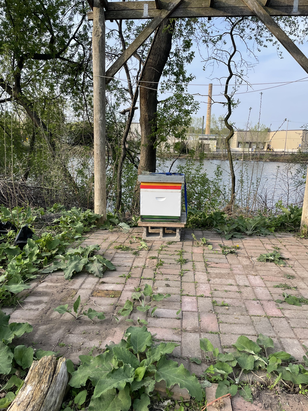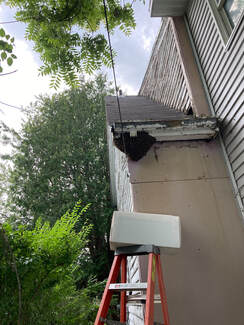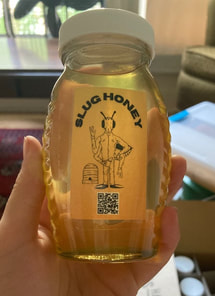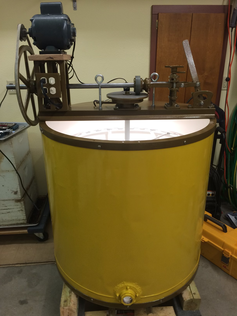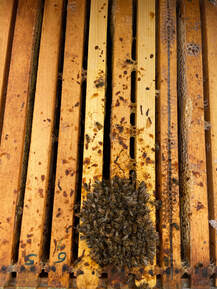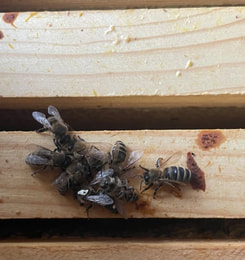Beekeeping at Lawrence
April
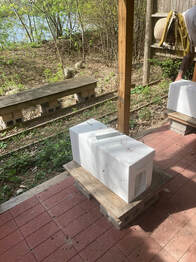 Boxes of Nucs
Boxes of Nucs
Every spring, Lawrence welcomes a new group of bees to our campus to replace the hives that sadly didn’t make it through the winter. The new bees come in nucleus’ (or nucs)—groups of a few thousand workers bees with one queen—that grow into hives containing anywhere from 20,000-100,000 bees. The first step is to transfer the bees into hive boxes. Here at LU, we use standard Langstroth hives. In the early part of spring before many flowers have bloomed, we feed the bees syrup (1:1 sugar to water). Early feeding is incredibly important for the young bees because it makes them ready to forage once flowers start blooming.
May
 A No Mow May sign in front of a participating house
A No Mow May sign in front of a participating house
Our lab facilitates No Mow May, encouraging our neighbors throughout Appleton and beyond to not mow their lawns for the month of May. The plants that grow in front lawns become food for bees (not just our honeybees but also for the 80+ native bee species found in Appleton). Getting food early in the season gives the bees a head start for the rest of the season. Usually, our honeybee populations grow enough during May that we add a second brood box to their hive for them to live in.
June
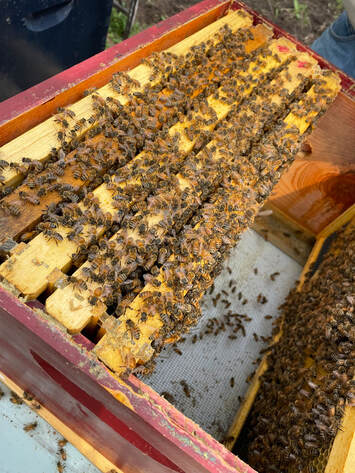 Bees hard at work inside their hive
Bees hard at work inside their hive
The summer months make for busy bees! Constantly foraging for goods, our bees are making the honey they will eat during the winter months. We check our hives 1-3x a week by weighing them. We try to avoid opening the hive and disturbing the bees as much as possible because the bees don’t like it and it increases the likelihood of accidentally killing bees. If the bees are losing weight, it indicates something might be wrong and we investigate. Our first course of action is to search for the queen and eggs. If there are eggs, there is most likely a healthy queen. Usually if a hive is losing weight during the summer, it means the queen has either left (maybe to form a new hive) or died without an heir. If a hive is queenless, we will put a comb of brood (larval baby bees) into the hive and the bees will choose one of those baby bees to be the next queen.
July
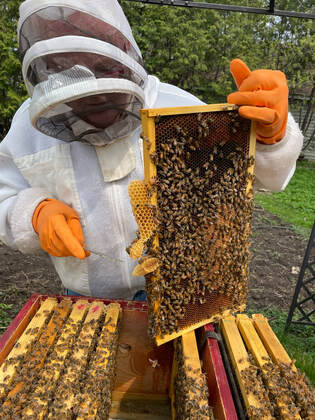 Checking a frame for eggs
Checking a frame for eggs
As the bees collect pollen and make honey, we give them give additional room by adding supers—shorter versions of the hive boxes—to the top of the hive. When the bees fill up all the frames with capped honey (wax-covered honeycomb), we take off the super and give them another. The honey from the supers is we harvest to eat ourselves. Our approach at LU is to harvest along the way, but many beekeepers may keep all the supers on their hive and harvest just once at the end of August. During July, we continue our weekly checks of the bees. In addition to checking the weight, we also check the bottom boards (boards underneath the hive that catch all the droppings), scanning for Varroa mites.
August
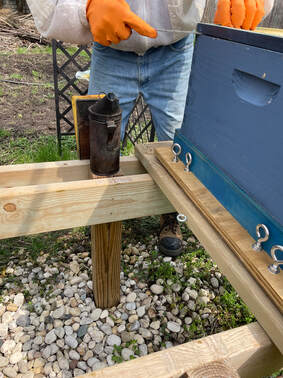 A smoker we use to clam down our bees before we open the hive
A smoker we use to clam down our bees before we open the hive
By the time August rolls around, most of the honey streams (times when many flowers are in bloom) are over and the honeybee populations start to decline in preparation for winter. With less honey production, we take the rest of the supers off. Once the supers come off, we can start treatment for the dreaded varroa mites. Varroa mites are one of the leading causes of hive death, because they live in brood cells with developing bees and are vectors of disease. At LU, we use oxalic acid to treat our bees for mites. Oxalic acid works by binding to the feet of the mite, which forces them fall off of their bee host. We try to treat our bees as infrequently as possible while still controlling infestation.
September
October
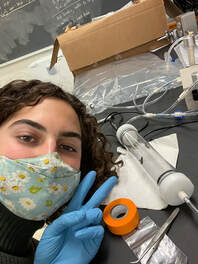 Student researcher collecting honeybee respiration data
Student researcher collecting honeybee respiration data
Our lab doesn't just raise honeybees because we love them and their honey (which we do)—we also use the bees in our research. Right now one of our lab projects is investigating the honeybee’s response to changing environmental temperatures. To do this, we take samples of bees every month of the year. We see what temperatures the bees can withstand and how the amount of CO2 (their breath) changes as they are exposed to increasingly warm temperatures. We are hoping to combine this data with microCT scan (just like CT scans for humans only smaller) to get a better picture of how different honeybee structures effect their function.
November
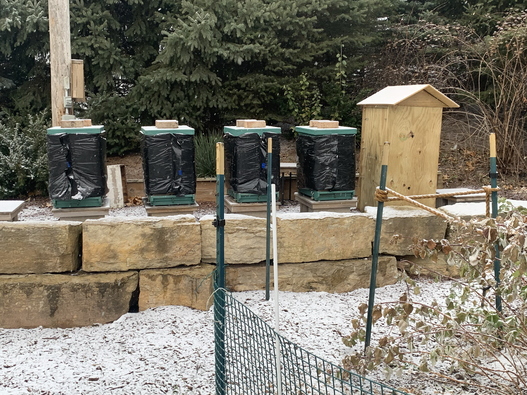 Four hives ready for winter, wrapped in Bee Cozies
Four hives ready for winter, wrapped in Bee Cozies
November is the last month we feed the bees, following the idiom: “Feed the bees for Thanksgiving, wrap them for Christmas”. We wrap our bees in what look like big, black trash bags called Bee Cozies. They slip over the top of the hive and provide insultation for the long, Wisconsin winter months.
In the fall, the hives are in full blown winter preparation mode. It is important to not rearrange the hives during inspections because the bees store their honey very specifically so that during the winter they can remain in their cluster while still accessing honey. Fall is a very competitive time for bees and they are known to enter other, weaker, hives and “rob” their honey. We reduce the size of their entrances to prevent this from happening.
In the fall, the hives are in full blown winter preparation mode. It is important to not rearrange the hives during inspections because the bees store their honey very specifically so that during the winter they can remain in their cluster while still accessing honey. Fall is a very competitive time for bees and they are known to enter other, weaker, hives and “rob” their honey. We reduce the size of their entrances to prevent this from happening.
December
January
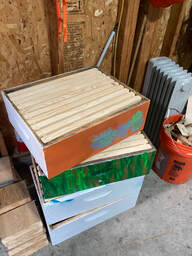 Building new hive boxes
Building new hive boxes
With the bees snuggled in for the winter, we use the quieter months to prep for the next season. With some downtime, we take the opportunity to clean up all our bee equipment. It is important to make sure all the honey and wax is stored properly to prevent the invasion of wax moths. If wax moths get into the comb, they eat and lay their eggs in it, rendering it useless for our bees. To prevent this fate, we first freeze the frames with comb on them, killing the larva that might be present, and then we store them away in airtight containers. Clean frames can be used again next year by the bees.
February
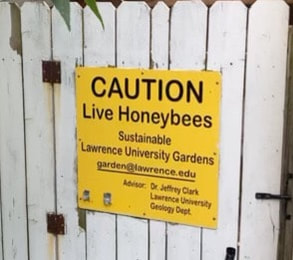
In February, it’s time to start thinking about the next generation of bees. Like many other beekeepers, we order packages in the winter so we can pick them up in April. We order our bees locally from Let It Bee, but the bees themselves come up from Georgia and other southern states. There are many different species of honeybee, each with their own unique characteristics. At LU, we have three types of bees; Italian, Carniolan (Carnie), and Buckfast honeybees.
March
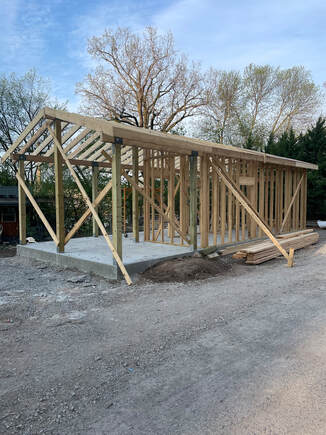 The pollinator center during construction
The pollinator center during construction
In March, we check on the bees to see who made it through the winter. Wisconsin winters are particularly tough on bees, with extreme cold spells punctured by warmer days which can confuse the bees. We set up new hives so that we are ready to go when the nucs arrive in April. This year, in March 2022, we started to build our pollinator center in S.L.U.G (Sustainable Lawrence University Garden). Come visit us and our bees along the fox trail!
